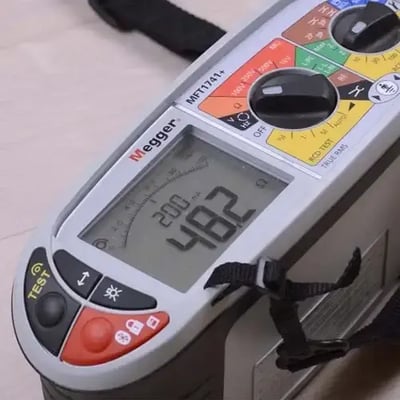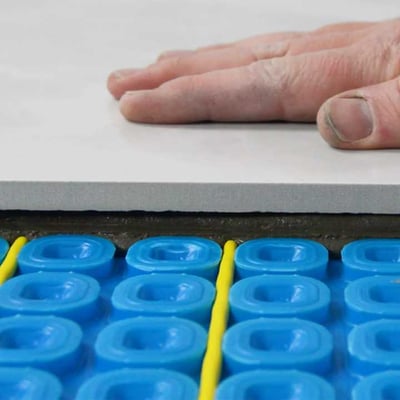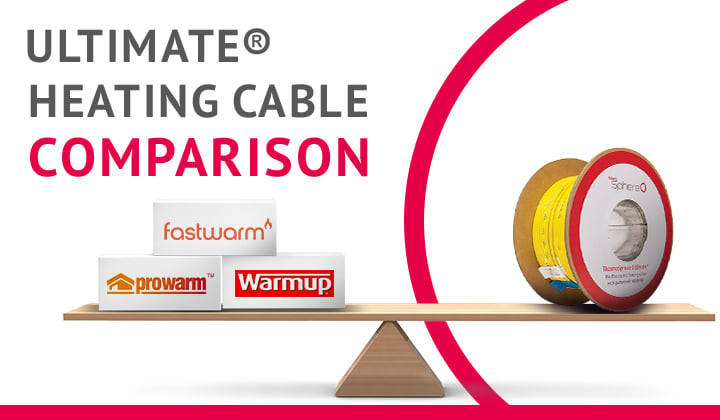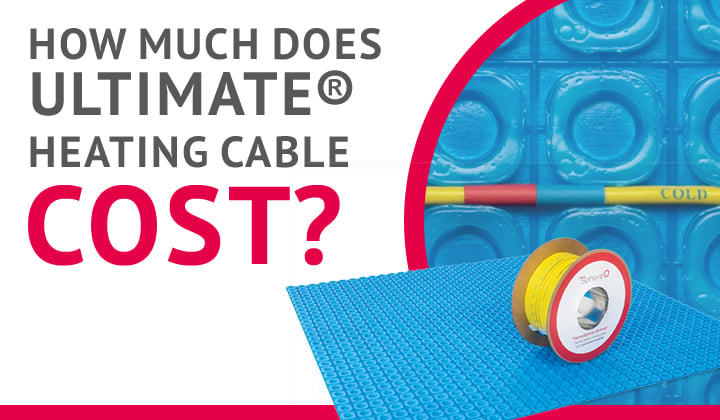If you’re exploring ways to add underfloor heating to your home, chances are you’ve come across ThermoSphere Ultimate® heating cable and Membrane mat. Together, they’re designed to give you a system that’s flexible to install, efficient to run and reliable for the long term.
But one of the first questions most people ask is: “How much will it cost to install?”
The answer isn’t the same for everyone. While the cable and membrane themselves are easy to price, the total project cost depends on factors like the size and shape of your room, the floor finish you choose, and whether you go DIY or hire a professional installer.
In this article, we’ll break down the main things that affect the upfront cost of Ultimate & Membrane, so you can budget with confidence and decide whether it’s the right solution for your project.
Room size and layout
 It’s no surprise that the bigger the space, the more cable and membrane you’ll need. But the layout of the room also makes a difference.
It’s no surprise that the bigger the space, the more cable and membrane you’ll need. But the layout of the room also makes a difference.
-
Large, regular-shaped rooms often work out cheaper per m², because the cable can be run in long, efficient loops with minimal cutting or repositioning of the membrane.
-
Small bathrooms or en-suites can sometimes be more expensive to install per m² because of the fiddly work required to cable around toilets, sinks and built-in furniture.
-
Irregular or complex rooms benefit from Ultimate & Membrane because the system is flexible, the cable locks securely into place no matter the shape, but more intricate work will increase labour time.
In practice, this means a 10m² open kitchen could be more cost-effective per m² than a 3m² bathroom. Find more examples in this blog.
Wattage selection (130W/m², 195W/m² or low output cable)
 ThermoSphere Ultimate® heating cable is available in different wattage outputs, which directly influence cost:
ThermoSphere Ultimate® heating cable is available in different wattage outputs, which directly influence cost:
-
130W per m² – Lower upfront cost, suitable as a primary heat source in standard applications. This is the more common choice.
-
195W per m² – Higher upfront cost due to larger quantity of cable required. Quicker heat up time, often used in room with higher heat loss levels, e.g. a conservatory or an older building.
- 57W / 85W per m² - designed for properties that need to manage their electrical loads carefully. Low heat loss properties are ideal, pairs very well with self generated solar electricity.
Ensure you choose the correct wattage for your room based on how you are going to use the space and how well insulated it is. If you're not sure, get in touch and one of our team can help you with any queries.
Floor finish
 The type of floor finish you choose has a big impact on both the process and the overall cost of installing ThermoSphere Ultimate with Membrane. Because the cable presses neatly into the membrane and the in-line joint is slim, the system gives installers a clean, stable base to work from, but what happens on top of that base can change the amount of preparation and specialist work required.
The type of floor finish you choose has a big impact on both the process and the overall cost of installing ThermoSphere Ultimate with Membrane. Because the cable presses neatly into the membrane and the in-line joint is slim, the system gives installers a clean, stable base to work from, but what happens on top of that base can change the amount of preparation and specialist work required.
Tile and stone are usually the most straightforward pairing with Ultimate and Membrane. They are excellent conductors of heat and can be laid directly over the system using standard adhesives, which means less time spent on additional layers or specialist methods. Wood and engineered timber, on the other hand, behave differently. These materials expand and contract with changes in temperature and moisture, so the installation has to allow for movement with expansion gaps and care must be taken to keep surface temperatures within safe limits. The membrane provides a stable decoupling layer that helps manage this movement, but the installation itself tends to be more involved than with tile.
Vinyl and luxury vinyl tiles also work well, but they require particular attention to adhesives and surface preparation. The finish has to be completely flat and the adhesive must be rated for use with underfloor heating. In some cases, installers add a thin levelling layer to ensure long-term stability.
Finally, poured finishes such as concrete or resin can take more planning, simply because of the way they’re laid and cured. They need a strong, flat subfloor and the correct preparation to ensure a good result. This can add a little more time to the project, but many installers see the combination with Ultimate and Membrane as a real advantage, because the built-in decoupling and waterproofing features provide extra stability beneath these more demanding finishes.
Subfloor preparation & insulation
 While you can lay Ultimate cable directly into a membrane mat on top of concrete or timber sub-floors, the most efficient installs always include insulation, here's why.
While you can lay Ultimate cable directly into a membrane mat on top of concrete or timber sub-floors, the most efficient installs always include insulation, here's why.
-
Insulation boards: £11–£16 per m²
-
Benefit: Reduce running costs by up to 50%
-
Result: Faster warm-up, reduced costs and a system that reflects heat into the room, rather than the subfloor
Other subfloor considerations include:
-
Stability & level: Cracks, dips or loose boards should be fixed before installing the membrane.
-
Moisture protection: A damp subfloor will damage both insulation and adhesive, so moisture barriers might be required.
-
Timber floors: May need strengthening or specialist insulation to avoid movement.
Skipping prep may save money upfront, but a properly prepared base ensures long-term efficiency and reliability.
Thermostat choice
 Thermostats are another area of your project where you may be tempted to try and save some money. Whilst your thermostat doesn't need to be able to fly or be made of solid gold, there are certain features that we should consider important when considering cost:
Thermostats are another area of your project where you may be tempted to try and save some money. Whilst your thermostat doesn't need to be able to fly or be made of solid gold, there are certain features that we should consider important when considering cost:
- Is it easy to use?
- Is it easy to connect? (Wi-Fi/Bluetooth)
- Is it a smart thermostat?
- Is there zonal control?
- Is there remote set-up available from the manufacturer?
There are several different types of thermostats available on the market, but they generally fall into two categories: manual and programmable.
Manual thermostats — essentially an on/off switch with a temperature dial — are the cheapest to buy. However, they are not suitable for use with primary heating systems, as they often do not meet the requirements of the Lot 20 regulations (the Ecodesign standards that apply to electric space heaters and their controls in the UK and EU).
Programmable thermostats — offer far more control. Like a boiler programmer, they allow you to set a heating schedule so your system switches on and off automatically at the times you choose, as well as the specific room temperatures you want to maintain. For underfloor heating, programmable thermostats come in several forms, including standard programmable models, Bluetooth-controlled versions and Wi-Fi-enabled thermostats, which allow for app control and smart integration.
To give you some examples:
ThermoSphere offers several thermostat models, the latest being the brand new T-MO thermostat. T-MO is designed with a single objective, making it easy for installers. It offers remote setup and support, copy and paste scheduling and has an upgraded warranty due to its ZeroX technology. It will sit at around £100*, make sure you register your interest today.
The Programmable thermostat (SCP-W-01) has been the bread-and-butter for almost 10 years, offering easy 7 day scheduling, adaptive-start learning, ambient and floor temperature sensing, plus an automatic open-window sensor. It's robust, self-reliant and reasonably priced at around £100–£115 ex VAT. Its main drawback is the lack of remote control or smart-home integrations, limiting flexibility for users who want an app or voice control.
The Bluetooth Programmable thermostat (BT21) adds app-based setup in under a minute, plus you can “copy & paste” settings to multiple units, ideal for streamlining larger installs. It typically costs £100–£120 ex VAT. Its disadvantage is that being Bluetooth-only, it lacks remote access when you're out of range. But for larger projects, you can use a BMS enabled switch to turn the thermostat from 'comfort' mode to 'eco mode, which is perfect for central control.
Finally, the Dual Control thermostat (DC-W-01/DC-B-01) combines underfloor heating control with a second switched output, useful for things like an electric towel rail or mirror demister. It includes window-open detection and features adaptive-start learning, costing £120–£130 ex VAT. Its drawback is the more complex wiring and higher power-handling requirements due to the second relay—this can complicate installation, especially for high-load circuits.
*accurate at the time of publishing
Labour & installation
 The final factor is installation. This is where the Ultimate & Membrane combination really shines: installers consistently praise how quickly the cable locks into the mat, saving time and reducing errors. The in-line hot-cold joint means no bulky connection to hide, and the TwistedTwin construction provides durability and reliability once it’s in place.
The final factor is installation. This is where the Ultimate & Membrane combination really shines: installers consistently praise how quickly the cable locks into the mat, saving time and reducing errors. The in-line hot-cold joint means no bulky connection to hide, and the TwistedTwin construction provides durability and reliability once it’s in place.
-
DIY with electrician sign-off: You can fit the membrane and cable yourself, then hire a qualified electrician for the final connection (£100–£200).
-
Professional installation: Typically £200–£400 per room, though more complex layouts may cost extra.
Remember: regulations require that a qualified electrician completes and certifies the connection. This is essential not just for warranty cover, but also for safety.
Key takeaways
The cost of installing ThermoSphere Ultimate® heating cable with Membrane depends on several factors, including:
To take a closer look at all the numbers, check out 'How much does ThermoSphere Ultimate® heating cable cost?' While upfront costs can range from £600 for a small bathroom to £1,500+ for larger kitchens or open-plan spaces, reviews show that the long-term value is clear. Customers consistently point to the combination of smart design features, ease of installation and reliable support as reasons they’d recommend Ultimate & Membrane to others.
✖️➕ Running cost calculator ➕✖️
❓📊How much does it cost?📊❓ ❓📊Running Costs📊❓
❓📊Cost Comparison 📊❓ ❓📊Is It Worth It (ROI) 📊❓
Electric heating made easy
Questions?
Or contact us via the website, or give one of the team a call on 01622 689440. Find out more about ThermoSphere by reading of one of our other blogs here.
If you want to find out more about some of the other fun stuff we've been up to, follow us on our social media:
LinkedIn: @thermosphere
YouTube: @thermosphere
Facebook: @thermosphere
Tiktok: @_thermosphere
Instagram: @_thermosphere



















 Jacob Bottley
Jacob Bottley

 It’s no surprise that the bigger the space, the more
It’s no surprise that the bigger the space, the more 
 The type of floor finish you choose has a big impact on both the process and the overall cost of installing
The type of floor finish you choose has a big impact on both the process and the overall cost of installing  While you can lay
While you can lay 
 The final factor is installation. This is where the
The final factor is installation. This is where the 

